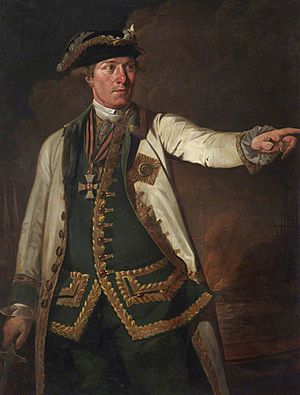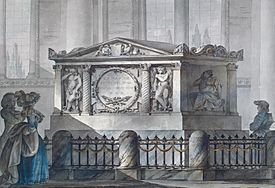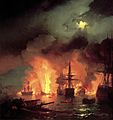Samuel Greig facts for kids
Quick facts for kids
Samuil Karlovich Greig
|
|
|---|---|

Greig in 1773 by Ivan Argunov
|
|
| Birth name | Samuel Greig |
| Born | 30 November 1735 Inverkeithing, Scotland |
| Died | 26 October 1788 Reval, on board Rostislav |
| Buried |
St. Mary's Cathedral, Tallinn
|
| Allegiance | Kingdom of Great Britain Empire of Russia |
| Service/ |
Royal Navy Imperial Russian Navy |
| Years of service | 1758–1764 (Britain) 1764–1788 (Russia) |
| Rank | Lieutenant (Britain) Vice-Admiral (Russia) |
| Commands held | Trekh Ierarkhov Pobeda Sviatoi Velikomuchenik Isidor |
| Battles/wars |
|
| Awards | Order of Saint Alexander Nevsky Order of Saint Vladimir |
| Relations | Aleksey Greig (son) Samuil Greig (grandson) |
Samuel Greig (born November 30, 1735, in Inverkeithing, Scotland – died October 26, 1788, in Tallinn, Estonia) was a Scottish-born admiral who became a hero in the Imperial Russian Navy. He was known in Russia as Samuil Karlovich Greig. He played a key role in important naval battles like the Battle of Chesma in 1770 and the Battle of Hogland in 1788. His son, Alexey Greig, also had a very successful career in the Russian Navy.
Contents
Samuel Greig was born in a town called Inverkeithing in Scotland. Before he joined the navy, he worked on his father's ships as a sailor. He joined the Royal Navy (Britain's navy) before 1758.
He took part in several important naval fights. These included the Capture of Gorée in 1758, the Battle of Quiberon Bay in 1759, and the Battle of Havana (1762). He was promoted to acting lieutenant in 1761, but it took a few years for this rank to be officially confirmed.
The Russian government asked Great Britain to send skilled British naval officers to help improve their own navy. Lieutenant Greig was chosen as one of these officers. His great skills quickly impressed the Russian government. He was soon promoted to the rank of captain in the Russian navy.
Family Connections
Samuel Greig married Sarah Cook. Their family later connected with Russian and German noble families.
His son, Alexey Greig, also became a famous admiral in the Russian Navy. Alexey had a very impressive career, receiving many honors.
Samuel Greig was also the father-in-law of Mary Somerville. She was a Scottish writer and scientist. Mary married Greig's fourth son, Captain Samuil Samuilovich Greig. He worked as the Russian Consul in London. They had two sons before he passed away in 1807. One of their sons, Woronzow Samuilovich Greig, became a lawyer and scientist.
His grandson, Samuil Alexeyvich Greig, became the Russian Minister of Finance from 1877 to 1880. He was a general-lieutenant and helped defend Sebastopol during the Crimea War.
The Battle of Chesma: A Fiery Victory

Some time after the war between Russia and Turkey began, Captain Greig was sent to the Mediterranean Sea in 1770. He was part of a fleet led by Alexei Grigoryevich Orlov and Admiral Grigory Spiridov.
They met the Turkish fleet near Chesma Bay in western Turkey. The Turkish fleet was much larger, with about 15 ships of the line, plus other ships. The Russian force had 9 ships of the line and 3 frigates. After a tough battle that didn't have a clear winner, the Turkish fleet moved closer to Chesma Bay during the night. They were protected by cannons on land.
Even though the enemy was in a strong position, the Russian admiral decided to attack. He planned to destroy the Turkish ships using fire-ships. These were old ships filled with flammable materials, set on fire, and sent into the enemy fleet.
At one in the morning, Captain Greig led the fire-ships towards the enemy. He successfully destroyed the entire Turkish fleet. Captain Greig, helped by another British officer named Lieutenant Drysdale, personally lit the fire-ships. After this dangerous task, they both jumped into the water and swam to their own boats. They did this while the Turks were firing at them and risking being caught in the explosions.
After this success, the Russian fleet attacked the town and the land batteries. By nine in the morning, almost nothing was left of the town, its defenses, or the Turkish fleet. For his important service, Captain Greig was immediately promoted to admiral by Count Orlov. This promotion was confirmed by the Empress of Russia herself.
A peace treaty was soon signed between Russia and Turkey. Admiral Greig continued to work hard to improve the Russian fleet. He updated their rules and inspired everyone to make the navy stronger. Because of his efforts, the Russian navy became one of the most powerful in Europe. The empress truly valued his work. She rewarded him by promoting him to the high rank of admiral of the Russian Empire and making him governor of Kronstadt.
The Battle of Hogland and His Final Days

Admiral Greig was involved in the Russo-Swedish War (1788–1790), which started in the summer of 1788. He fought an important but undecided battle against the Swedish navy during the Battle of Hogland. After this, he blockaded the Swedish fortress of Sveaborg.
However, he became very ill with a high fever. He was taken to Tallinn (then called Reval) and died on October 26, 1788. He passed away on board his own ship, the Rostislav, after only a few days of illness. He was 53 years old. When the empress heard he was sick, she was very worried. She immediately sent her top doctor, Dr. Rogerson, to Tallinn to help him. But even with the doctor's skill, Admiral Greig could not be saved.
Admiral Greig's funeral in the Tallinn Cathedral was a very grand event. For several days before the funeral, his body was displayed in the admiralty hall. Then, it was carried to the grave on a beautiful funeral carriage pulled by six horses. Many important people, including nobles, clergy, and naval and military officers, attended the procession. Large groups of soldiers escorted them. Bells tolled and cannons fired from the city walls and the fleet. Everything showed how much the empire mourned the loss of such an important person. Catherine, the Empress of Russia, even had her architect, Giacomo Quarenghi, design Greig's tomb.
Honours and Legacy
Samuel Greig was recognized for his contributions in various ways. In 1864, a type of plant called Greigia was named after him. This was done by Eduard August von Regel, who was the director of the St. Petersburg Botanical Garden.
Later, in 1873, Regel also named a type of Tulip after him, called Tulipa greigii. This was because Greig had once been the president of the Russian Horticultural Society.
Images for kids





